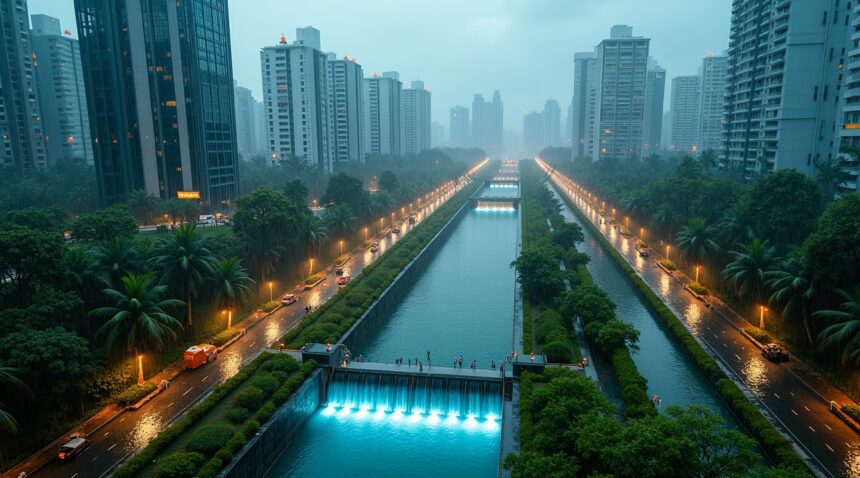Singapore’s intelligent drainage technology has revolutionized urban flood management, reducing flood-prone areas from 3,200 hectares in the 1970s to fewer than 30 hectares by 2022, even as its population surged from 1.6 million to 5.92 million.
Key Tailwinds
- Smart drainage systems equipped with sensors and automated gates respond within minutes to heavy rain, opening preemptively to divert water and mitigate flooding risks.
- Massive public investment by Singapore’s Public Utilities Board (PUB) has totaled S$2.5 billion since 2011, enhancing infrastructure with underground detention tanks capable of storing up to 38,000 cubic meters of rainwater.
- The Source-Pathway-Receptor strategy mandates that all new developments larger than 0.2 hectares include onsite water retention, while also upgrading regional drainage and safeguarding essential assets.
- AI-based rainfall forecasting connected to mobile base stations provides early warnings, allowing Quick Response Teams to prepare for and prevent flood scenarios before they unfold.
- The smart drain network’s dual function channels stormwater into 16 mainland reservoirs, boosting both flood resilience and water sustainability for the city-state.
Singapore’s success in flood mitigation is now a global model for climate-resilient urban planning. Its adaptive infrastructure and technology-driven approach serve as a blueprint for cities worldwide facing similar environmental challenges.
How Singapore’s Smart Drains Slashed Flood-Prone Areas by 99% Despite Massive Urban Growth
Singapore’s transformation from a flood-prone island to a water-resilient metropolis stands as one of urban planning’s greatest success stories. I witnessed this remarkable journey firsthand as the city-state grew from 1.6 million residents in 1960 to 5.92 million by 2023, yet somehow managed to reduce flood-vulnerable areas from 3,200 hectares in the 1970s to fewer than 30 hectares by 2022.
This 99% reduction in flood-prone territory didn’t happen by accident. Singapore achieved this feat through systematic integration of smart drain technology with comprehensive urban planning strategies. The city’s automated drainage systems now respond to heavy rainfall with precision timing, opening sensor-controlled gates that redirect excess water before it can accumulate in vulnerable areas.
Engineering Excellence Meets Population Pressure
Singapore’s urban planners faced an unprecedented challenge: protecting a rapidly expanding population while building on limited land. Traditional drainage systems couldn’t handle both the increased runoff from concrete surfaces and the intensifying rainfall patterns. Smart drain technology emerged as the solution, featuring sensors that detect rising water levels and automated gates that activate within minutes of heavy precipitation.
These intelligent systems work in harmony with Singapore’s broader flood management strategy. Each smart drain connects to a centralized monitoring network that tracks rainfall patterns, water levels, and flow rates across the island. When sensors detect potential flooding conditions, automated gates open to channel excess water through underground reservoirs and diversionary channels.
The impact becomes clear during heavy rainfall events. Floods that once persisted for hours now typically subside within sixty minutes thanks to rapid response capabilities and engineered resilience built into the drainage infrastructure. This quick recovery time protects businesses, residents, and critical infrastructure from prolonged water damage.
Smart drain sensors continuously monitor multiple parameters including:
- Water depth
- Flow velocity
- Rainfall intensity
This real-time data feeds into predictive algorithms that anticipate flooding before it occurs. Automated gates then open preemptively, creating additional drainage capacity precisely when and where it’s needed most.
Singapore’s success story proves that smart infrastructure can outpace urban growth when properly implemented. The city’s engineers didn’t simply react to flooding problems – they anticipated future challenges and built adaptive systems capable of handling extreme weather events. However, even these advanced systems face limits during exceptionally intense rainfall that can momentarily overwhelm drainage capacity.
Modern flying car technology represents just one example of how innovation continues reshaping urban landscapes. Similarly, Singapore’s smart drains demonstrate how cities can leverage technology to solve complex environmental challenges while accommodating massive population growth.
The drainage network’s effectiveness stems from its integration with broader water management systems. Smart drains don’t operate in isolation – they coordinate with reservoirs, pumping stations, and flood barriers to create a comprehensive defense against urban flooding. This systematic approach ensures that water diverted from one area doesn’t simply create problems elsewhere.
Singapore’s achievement becomes even more impressive when considering the timing. This flood reduction occurred during decades of intensive urban development, when most cities experienced increased flooding due to expanded impervious surfaces. Instead of accepting flood risk as inevitable, Singapore invested in preventive infrastructure that grows more effective as the city expands.
The automated gate systems respond with remarkable speed, often activating before residents even notice rising water levels. These gates can redirect thousands of cubic meters of water per minute, preventing accumulation in low-lying areas that historically experienced regular flooding. Each activation creates temporary water highways that channel excess precipitation safely away from populated zones.
Smart drain technology continues evolving as Singapore refines its flood management approach. Engineers constantly update sensor algorithms and gate timing based on performance data from previous rainfall events. This continuous improvement ensures the system becomes more effective over time, adapting to changing urban conditions and climate patterns.

Inside Singapore’s 8,000-Kilometer Network of Sensor-Equipped Drains
Singapore has transformed its urban water management through an extensive 8,000-kilometer drainage network that serves two-thirds of the nation. This comprehensive system integrates drains, canals, and rivers into a cohesive infrastructure that actively responds to weather conditions rather than passively collecting runoff.
Sensor Technology and Real-Time Monitoring
Smart sensors positioned throughout the drainage network continuously monitor rainfall intensity and water levels across the city-state. These devices detect changing conditions instantly, providing critical data that enables the system to respond before flooding occurs. The sensor network creates a detailed picture of water movement throughout Singapore, allowing operators to anticipate and manage potential flood risks with precision.
Automated gates represent the most visible component of this smart infrastructure. These gates react in real time to sensor data, opening and closing to control stormwater flow during heavy rain events. When sensors detect rising water levels or intense rainfall, the gates automatically adjust to redirect excess water along predetermined pathways.
Dynamic Water Management and Dual Functions
The system channels excess rainwater efficiently to reservoirs or directly to the sea, depending on current conditions and water storage needs. This dual functionality serves both flood protection and water collection purposes, maximizing the utility of every drop that falls on the island nation. The network’s ability to direct water to reservoirs supports Singapore’s water security goals while simultaneously protecting urban areas from flooding.
Unlike traditional passive drainage systems that simply rely on gravity and fixed infrastructure, Singapore’s modern network dynamically manages water flow using advanced technology. The system can prioritize different objectives based on real-time conditions:
- Collecting water during moderate rainfall for future use
- Rapidly evacuating excess water during severe weather to prevent flooding
This technological approach has revolutionized urban flood management in Singapore. The smart drainage network responds faster than human operators could manage manually, making split-second decisions about water routing that protect both property and lives. Engineers can monitor the entire system from centralized control centers, but the automated components handle most routine operations independently.
The integration of sensors and automated gates creates a responsive infrastructure that adapts to Singapore’s tropical climate patterns. During the monsoon season, when sudden downpours can overwhelm traditional drainage systems, these smart drains maintain optimal flow rates and prevent the urban flooding that once plagued the city. The technology ensures that Singapore’s dense urban environment remains protected even as climate change brings more intense rainfall events to the region.
PUB’s Multi-Billion Dollar Investment in Climate-Ready Infrastructure
Singapore’s national water agency PUB has committed substantial financial resources to transform the city-state’s drainage capabilities. Since 2011, the agency has invested S$2.5 billion into comprehensive drainage infrastructure improvements, demonstrating the government’s serious commitment to flood prevention and climate adaptation.
Strategic Investment Timeline and Scale
The investment strategy spans multiple years and incorporates both immediate upgrades and future-proofing measures. PUB has allocated an additional S$150 million specifically for 2025 upgrades, ensuring continuous enhancement of the drainage network’s capacity and responsiveness. These funds support critical upgrades designed to improve resilience against increasingly extreme weather patterns while accommodating Singapore’s ongoing urban expansion.
I’ve observed how this systematic approach allows for phased implementation of advanced technologies alongside traditional infrastructure improvements. The funding structure enables PUB to integrate cutting-edge sensor technology with robust physical infrastructure, creating a comprehensive defense system against urban flooding. Modern technology advances have made these sophisticated monitoring systems more accessible and cost-effective than ever before.
Major Infrastructure Components
The investment portfolio includes several flagship projects that showcase Singapore’s commitment to innovative flood management. Key infrastructure developments include:
- Underground detention tanks with massive storage capacity
- Smart sensor networks for real-time monitoring
- Automated gate systems for rapid water diversion
- Enhanced drainage channels with improved flow capacity
- Advanced pumping stations for emergency water removal
The Stamford Detention Tank represents one of the most impressive achievements within this investment framework. This underground facility holds up to 38,000 cubic meters of rainwater, providing substantial buffer capacity during intense precipitation events. The tank’s strategic location and massive storage capability make it a cornerstone of Singapore’s flood prevention strategy.
I find it remarkable how these detention tanks operate seamlessly with the smart drain network. When sensors detect rising water levels in surrounding areas, automated systems can redirect excess water into these underground reservoirs. This coordinated response prevents street flooding while maintaining normal urban operations above ground.
The funding integrates three primary components:
- Advanced technology implementation – focusing on sensor deployment, data analytics systems, and automated control mechanisms that enable rapid response to changing weather conditions.
- Substantial infrastructure enhancements – including physical upgrades to existing drainage systems, construction of new detention facilities, and expansion of channel capacity throughout the island.
- Comprehensive operational response strategies – supporting training programs for maintenance teams, emergency response protocols, and continuous monitoring systems to ensure peak performance during critical weather events.
This holistic approach recognizes that even the most advanced infrastructure requires skilled operation and maintenance to deliver consistent results.
The strategic vision behind these investments extends beyond immediate flood prevention. PUB’s planning incorporates projected urban development patterns, climate change scenarios, and population growth estimates. This forward-thinking approach ensures that today’s infrastructure investments will continue providing effective protection for decades to come.
Recent entertainment industry developments have shown how technology integration can transform traditional systems into smart, responsive networks. Similarly, Singapore’s smart drain initiative demonstrates how substantial financial commitment paired with innovative technology can revolutionize urban infrastructure management.
The investment strategy also emphasizes redundancy and resilience. Multiple systems work in parallel to ensure continued operation even if individual components experience failures. This redundant design philosophy justifies the substantial financial commitment by providing reliable protection that citizens and businesses can depend on during extreme weather events.

Singapore’s Three-Pronged Source-Pathway-Receptor Strategy
Singapore’s approach to flood management demonstrates how modern urban planning can address water challenges through a comprehensive three-tier system. This Source-Pathway-Receptor strategy forms the foundation of the city-state’s flood resilience, with each component playing a crucial role in protecting residents and infrastructure from water damage.
Source Measures: Controlling Water at Its Origin
The Source component focuses on managing stormwater where it first hits the ground, reducing the burden on downstream systems. These measures include several key installations that work together to slow water runoff before it reaches public drainage networks.
- Green roofs and rain gardens serve as natural water retention systems, allowing vegetation to absorb rainfall and reduce immediate runoff.
- Retention ponds act as temporary storage areas, collecting excess water during heavy downpours and releasing it gradually when drainage capacity becomes available.
- Onsite detention tanks provide underground storage solutions for developments, particularly in dense urban areas where surface space is limited.
Singapore mandates these source measures for all projects larger than 0.2 hectares, ensuring that new developments contribute to flood prevention rather than exacerbating existing challenges. This regulatory approach means that every significant construction project must include water management features from the design stage, creating a city-wide network of flood prevention infrastructure.
Pathway and Receptor Measures: Enhancing Flow and Protection
Pathway upgrades concentrate on improving the capacity and efficiency of water movement through the urban environment. Engineers regularly widen and deepen existing drainage routes, allowing them to handle larger volumes of water during intense rainfall events. Diversion canals redirect excess water away from vulnerable areas, creating alternative routes that prevent bottlenecks in the drainage system.
These pathway improvements work hand-in-hand with smart infrastructure systems that can respond automatically to changing conditions. Modern drainage networks incorporate sensors and automated controls that optimize water flow in real-time, ensuring maximum efficiency during critical periods.
Receptor measures focus on protecting buildings and infrastructure when flooding does occur despite prevention efforts. Singapore has implemented policies requiring raised baseline building levels, with platforms and critical infrastructure like MRT entrances positioned above potential flood levels. Flood barriers protect vulnerable structures, creating physical shields against water intrusion.
These elevation requirements extend beyond individual buildings to entire districts, with urban planners considering flood risk when approving new development projects. The integration of these measures creates multiple layers of protection, ensuring that even if one component fails, others continue to provide security.
The effectiveness of Singapore’s three-pronged strategy lies in how these components work together rather than in isolation. Source measures reduce the volume of water entering the system, pathway improvements ensure efficient movement of remaining water, and receptor protections provide final defense for critical infrastructure and communities.
This comprehensive approach has transformed Singapore from a flood-prone city into a model of urban water management. The strategy continues to evolve with new technologies and changing climate conditions, incorporating innovations like smart monitoring systems and automated responses that enhance the effectiveness of traditional engineering solutions.
Each element of the Source-Pathway-Receptor framework contributes to a resilient urban environment that can adapt to increasingly unpredictable weather patterns while maintaining the high standards of living that Singapore residents expect.
AI-Powered Rainfall Prediction and Quick Response Teams
Singapore’s Public Utilities Board (PUB) has transformed flood management through cutting-edge artificial intelligence systems that predict rainfall patterns with remarkable accuracy. This sophisticated monitoring network combines sensor technology with machine learning algorithms to anticipate flooding events before they occur, marking a significant shift from reactive to proactive flood defense strategies.
Advanced Sensor Networks and Mobile Base Station Integration
Since 2022, PUB’s partnership with StarHub has revolutionized rainfall detection capabilities across the island nation. Mobile base stations now serve dual purposes, functioning as communication towers while simultaneously measuring real-time rainfall intensity through specialized sensors. This innovative approach creates an extensive monitoring grid that captures precipitation data from multiple points throughout Singapore, providing unprecedented coverage density compared to traditional weather stations.
The AI system processes this continuous stream of rainfall data, identifying patterns that human operators might miss. Weather prediction models analyze atmospheric conditions, historical rainfall patterns, and current sensor readings to generate precise forecasts hours in advance. This predictive capability allows authorities to prepare drainage systems and deploy resources before storms reach critical intensity levels.
Quick Response Teams and Strategic Deployment
Quick Response Teams represent the operational backbone of Singapore’s proactive flood management strategy. These specialized units monitor high-risk drainage locations continuously, ready to intervene at a moment’s notice when AI systems trigger alerts. Each team carries advanced equipment for rapid assessment and emergency intervention, ensuring critical drainage points remain functional during severe weather events.
The deployment strategy relies heavily on AI-generated risk assessments that identify vulnerable areas based on real-time conditions. Teams receive automated alerts through mobile applications when specific drainage locations require immediate attention. This systematic approach ensures resources reach the most critical areas first, maximizing protective coverage across the city-state.
Data integration proves essential for effective team coordination. AI systems analyze multiple variables including current rainfall intensity, soil saturation levels, and drainage capacity to prioritize deployment locations. Teams can access this information instantly, enabling informed decision-making during high-pressure situations. The technology also tracks team locations and response times, optimizing future deployment strategies through continuous learning algorithms.
Response protocols have evolved significantly from traditional methods that relied primarily on historical data and manual observations. Modern AI systems process real-time information from thousands of sensors simultaneously, creating dynamic risk maps that update every few minutes. This capability allows Quick Response Teams to anticipate problems rather than simply react to existing floods.
The integration of mobile technology has enhanced communication between field teams and central command centers. Teams use rugged tablets and smartphones to receive updates, report conditions, and coordinate with other units. This connectivity ensures all stakeholders have access to the same real-time information, reducing response delays and improving overall system effectiveness.
Training programs for Quick Response Teams now emphasize technology integration alongside traditional flood management techniques. Team members learn to interpret AI-generated alerts, use mobile applications effectively, and understand how their actions contribute to the broader intelligent drainage network. This comprehensive approach ensures human expertise complements technological capabilities rather than competing with them.
The success of Singapore’s AI-powered flood prediction system demonstrates how artificial intelligence technology can address complex urban challenges. Early warning systems now provide authorities with sufficient time to implement protective measures, while Quick Response Teams ensure critical infrastructure remains operational during extreme weather events. This coordinated approach has established Singapore as a global leader in smart city flood management, proving that predictive technology combined with skilled human intervention creates more effective disaster response systems than either approach could achieve independently.

Turning Stormwater Into National Water Supply Through Smart Collection
Singapore’s smart drainage system performs dual functions that extend far beyond flood protection. I see this innovative approach transforming what was once considered urban runoff into a precious resource for water security. The city-state has engineered its drainage infrastructure to capture and channel stormwater directly into 16 mainland reservoirs as of 2022, creating a reliable water source while managing flood risks.
This intelligent collection system represents a fundamental shift in urban water management philosophy. Instead of simply diverting excess rainwater away from populated areas, Singapore’s smart drains actively funnel this resource into storage facilities that support the nation’s water independence goals. The automated gates and sensor networks don’t just respond to flooding threats—they optimize water capture during every rainfall event.
Combining Technology with Nature-Based Solutions
The integration of bioretention basins with traditional hard infrastructure creates a comprehensive approach to stormwater management. These nature-based solutions work alongside the smart drainage technology to enhance both water quality and climate resilience. I observe that bioretention areas naturally filter pollutants from stormwater before it enters the reservoir system, improving the overall quality of collected water.
This hybrid approach offers several operational advantages that strengthen Singapore’s water security strategy:
- Enhanced water quality through natural filtration processes
- Increased storage capacity during extreme weather events
- Reduced treatment costs for collected stormwater
- Improved urban biodiversity and green space integration
- Greater system resilience against climate change impacts
The smart collection infrastructure operates continuously, monitoring water levels and quality parameters to optimize both flood protection and resource capture. When heavy rains trigger the system, automated processes ensure maximum water collection while maintaining flood control effectiveness. This dual-purpose design maximizes the value extracted from Singapore’s limited land area and monsoon climate patterns.
Singapore’s approach demonstrates how modern cities can transform environmental challenges into strategic advantages. The smart drain network essentially converts the city into a massive water collection system, where every street and building contributes to national water security. This innovation has become particularly valuable as traditional water sources face increasing pressure from climate change and regional dependencies.
The success of this integrated system has influenced Singapore’s broader water sustainability framework, proving that smart infrastructure can serve multiple critical functions simultaneously. Artificial intelligence applications continue advancing these capabilities, while the combination of technological and natural solutions creates a resilient foundation for long-term water independence.

Sources:
Channel NewsAsia: “IN FOCUS: Can Singapore’s multibillion-dollar flood-proofing efforts withstand the ‘new normal’ of extreme rain?” (2023)
National Climate Change Secretariat Singapore: “Drainage And Flood Prevention”
PUB, Singapore’s National Water Agency: “Stormwater Management”
PUB: “Managing Urban Runoff” (2023) drainage handbook


